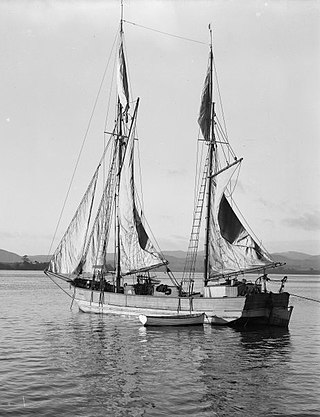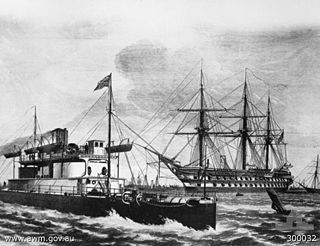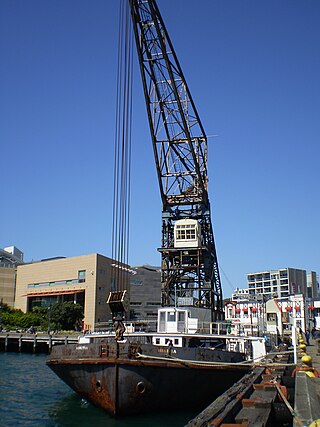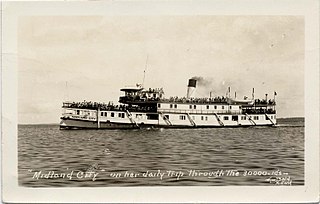
A torpedo boat is a relatively small and fast naval ship designed to carry torpedoes into battle. The first designs were steam-powered craft dedicated to ramming enemy ships with explosive spar torpedoes. Later evolutions launched variants of self-propelled Whitehead torpedoes.

A scow is a smaller type of barge. Some scows are rigged as sailing scows. In the 19th and early 20th centuries, scows carried cargo in coastal waters and inland waterways, having an advantage for navigating shallow water or small harbours. Scows were in common use in the American Great Lakes and other parts of the U.S., Canada, southern England, and New Zealand. In modern times their main purpose is for recreation and racing; there are also garbage scows for aquatic transport of refuse.

TEV Wahine was a twin-screw, turbo-electric, roll-on/roll-off passenger ferry. Ordered in 1964, the vessel was built by the Fairfield Shipbuilding and Engineering Company, in Govan, Glasgow, Scotland for the Union Steam Ship Company's Wellington-Lyttelton Steamer Express Service in New Zealand.

Sydney Heritage Fleet, is the trading name of Sydney Maritime Museum Ltd., a public company in Sydney, New South Wales, Australia.

Before Federation in 1901 five of the six separate colonies maintained their own naval forces for defence. The colonial navies were supported by the ships of the Royal Navy's Australian Station which was established in 1859. The separate colonies maintained control over their respective navies until 1 March 1901, when the Commonwealth Naval Forces was created.

HMQS Mosquito was a torpedo boat operated by the Queensland Maritime Defence Force and Commonwealth Naval Forces. She entered service in 1885 and after Federation was transferred to the Commonwealth Naval Forces, serving as a training vessel until she was paid off in 1910.

A motor launch (ML) is a small military vessel in Royal Navy service. It was designed for harbour defence and submarine chasing or for armed high-speed air-sea rescue. Some vessels for water police service are also known as motor launches.

The harbour defence motor launch (HDML) was a 72 ft (22 m) long British-designed motor vessel used for harbour defence during World War II. Nearly 500 were built by numerous Allied countries during the war.

A range of naval vessels were used in New Zealand from its early settlement years to the formation of the New Zealand Naval Forces in 1913. In the mid-19th century, these vessels included frigates, sloops, schooners, and steam-driven paddlewheel boats. In 1846, five years after New Zealand was first proclaimed a colony, it bought its first gunboat. In the 1840s and 1850s, steam boats were used to survey the ports and the coastline. In the 1860s, New Zealand established the Waikato flotilla, its first de facto navy.

HMQS Midge was a torpedo launch that served with the Queensland Maritime Defence Force, the Commonwealth Naval Forces and the Royal Australian Navy. After entering service in 1887, Midge served as "picquet boat" along the Brisbane River until Federation in 1901, when she was transferred to the Commonwealth. After this, she served as a training boat until 1912 when she was decommissioned.

Hikitia is a working self-propelled floating steam crane in Wellington Harbour, New Zealand. She is thought to be the only working steam crane of her type in the world.

RMS Atrato was a UK iron-hulled steamship. She was built in 1853 for the Royal Mail Steam Packet Company as a side-wheel paddle steamer, and at the time of her launch was the world's largest passenger ship. In 1870 RMSP traded Atrato in, causing her to lose the status of "Royal Mail Ship". She was converted to a single screw ship with a compound steam engine in 1872, and placed on the Aberdeen Line that chartered her to run to Victoria and New Zealand. In 1880 she was renamed Rochester before sinking four years later in 1884 by running aground.
HMVS Lonsdale was a second-class torpedo boat constructed for the Victorian Naval Forces and later operated by the Commonwealth Naval Forces and the Royal Australian Navy. She was sunk on mud flats on Swan Island in Port Phillip Bay in 1912 after being stripped of equipment and machinery. Having been commissioned in 1884, and then officially joining the Commonwealth Naval forces in 1901, the boat was the oldest ship in the Royal Navy, and is the oldest Royal Australian Navy ship still in existence.

The colonial service Defender-class torpedo boats were designed by Thornycroft & Company for the defence of New Zealand, built at Chiswick in 1883 and shipped to New Zealand. They were quickly obsolete and were left to deteriorate in situ. The remains of Defender are preserved at the Lyttelton Torpedo Boat Museum.

HMS Taiaroa was a colonial service Defender-class torpedo boat designed by Thornycroft & Company for the defence of New Zealand. She was named after Te Matenga Taiaroa, a 19th-century Māori chief of the Ngāi Tahu iwi. She was built at Chiswick in 1883 and shipped to New Zealand, where she was assigned to the defence of Port Chalmers.

The two colonial service Acheron-class torpedo boats were built by the Atlas Engineering Company at Sydney in 1879 for the New South Wales naval service. They were originally armed with a single spar torpedo, but this was replaced in 1887 with two 14-inch automotive torpedoes. They were sold in 1902.

Excelsior is an authentically restored fishing smack of the Lowestoft fishing fleet and a member of the National Historic Fleet. She was built by John Chambers of Lowestoft in 1921 and worked until 1936 before being converted into a motor coaster.

SS Midland City was originally a Canadian side-wheel steamboat that provided passenger and cargo transportation on the Great Lakes from 1871 until 1955. Originally named Maud, then America, she underwent several extensive refits over her 84-year service, and saw several owners. The ship was intentionally run aground and burnt to the waterline in 1955 near the mouth of the Wye River in Midland Bay. The wreck is intact and visible above the water to this day, where it acts as a breakwater for the Wye Heritage Marina and local attraction.

Mullogh was a ketch rigged steam ship, built in 1855 in Belfast. It sailed to Australia, then to New Zealand. The wreck of Mullogh is now beached on Quail Island.

Kaludah was a K-class ferry on Sydney Harbour, Australia. Commissioned in 1909, the timber-hulled steamer was built for Sydney Ferries Limited during the boom in cross-harbour ferry travel prior to the 1932 opening of the Sydney Harbour Bridge. Like the other "K-class" ferries, she was double-deck, double-ended, steam-powered screw ferry. However, she and the larger but otherwise similar Kookooburra (1907), were the only two K-class ferries designed by naval architect Walter Reeks and not Sydney Ferries Limited's Captain Summerbell.




















